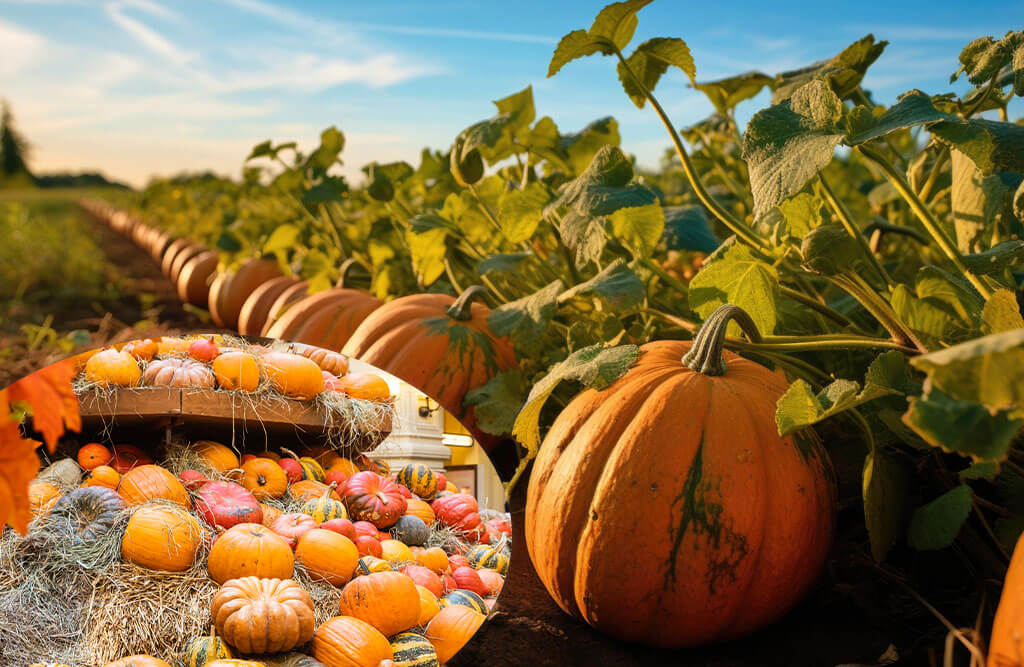By khetivyapar
Posted: 24 Nov, 2023 12:00 PM IST Updated Wed, 09 Oct 2024 10:05 AM IST
Pumpkin cultivation can be a lucrative and secure means of agricultural development. Cultivating it using advanced technical methods provides farmers with balanced and healthy produce, eliminating the need for intervention. Additionally, due to the high value addition of pumpkins and increased demand in the market, farmers can reap substantial benefits. Adhering to relevant techniques, organic fertilizers, and key regulations for safe farming, a farmer can achieve success in pumpkin cultivation. With the guaranteed high value addition of pumpkins, coupled with the production of premium quality products at the right time, farmers can secure a profitable and sustainable income.
Pumpkin Cultivation:
Source of Sustained Income Pumpkin cultivation has emerged as an excellent source of sustained income for farmers due to consistent rising demand and high value addition. If you are interested in pumpkin cultivation, here is research on its profitable aspects:
- Scientific Farming Techniques: Study scientific techniques to achieve success in pumpkin cultivation. Proper seed selection, use of appropriate fertilizers, and techniques like timely watering can enhance productivity.
- Monetary Value Addition in the Market: To enhance the market value of pumpkins, sell fully matured produce at the right time.Timely presence in the market can result in substantial profits.
- Exploring Organic Farming: Nowadays, organic farming is gaining popularity, and pumpkin cultivation can be part of it. Produce from organic farming can provide higher value addition and contribute to the growing demand for healthy and natural products.
- Government Schemes and Support: Utilize government schemes and agricultural support to boost your pumpkin cultivation. This can provide various benefits and financial support.
- Fertilizers: Pumpkins require rich nutrients in the soil. They perform well in soil containing sufficient manure and compost. When fertilizers are mixed with the soil, pumpkins grow even larger. Based on the growth stage of pumpkins, three main nutrients—nitrogen, phosphorus, and potassium—are essential.
Apply a higher concentration of nitrogen in the initial growth stage. This supports leaf, root, and vine development. Be cautious of direct contact between vines and weeds. Excessive nitrogen can burn the plants and reduce the formation and quantity of flowers and fruits.
Planting: If direct seeding is done, sow 5 seeds per hill, at a depth of 5-7 centimeters. After approximately 1-2 weeks of germination, leave 3-4 healthy seedlings in each hill. If necessary, apply fungicide to the soil as a drench to prevent attacks from fungi and use pesticides for insect control, such as cutworms and mole crickets. Ensure that the plants receive sufficient and uniform watering. Keep the plants weed-free for the first 5 weeks, and afterward, no other pest control is usually necessary.
Benefits of Pumpkin Cultivation:
- Highly Profitable: Pumpkin cultivation is a highly profitable agricultural option that can provide farmers with a sustainable income. Due to its high value addition and increased market demand, farmers can prosper.
- Adopt Advanced Techniques: By studying advanced techniques for success, a farmer can make their Pumpkin farming more progressive. Studying proper fertilizers, seed selection, and fundamental farming techniques can lead to higher productivity.
- Development of Organic Farming: Cultivating pumpkins organically can yield products with higher value addition, catering to the rising demand for natural and healthy products.
- Government Support: Utilizing government schemes and agricultural support can provide farmers with numerous benefits and financial assistance.
Drawbacks of Pumpkin Cultivation:
- Climate Challenges: Pumpkin cultivation may not be suitable in some regions, especially those with extreme climates, such as high temperatures and heavy snowfall.
- Disease and Pest Management: Pumpkin plants are particularly susceptible to diseases and pests. Lack of proper management can result in damage to plants from insects and diseases.
- Market Discrepancies: Although farmers cultivate pumpkins, market discrepancies often occur, leading to a reduction in prices.
- Market Pressure: If there is an oversupply of pumpkins in the market during cultivation, it can lead to a decrease in prices, causing losses for the farmer.
Conclusion: pumpkin farming in India has the potential to be a profitable venture due to the growing demand for pumpkins, the suitability of the climate for growing pumpkins, the low investment and maintenance costs, the high yield potential, and the opportunity to process pumpkins into value-added products.
